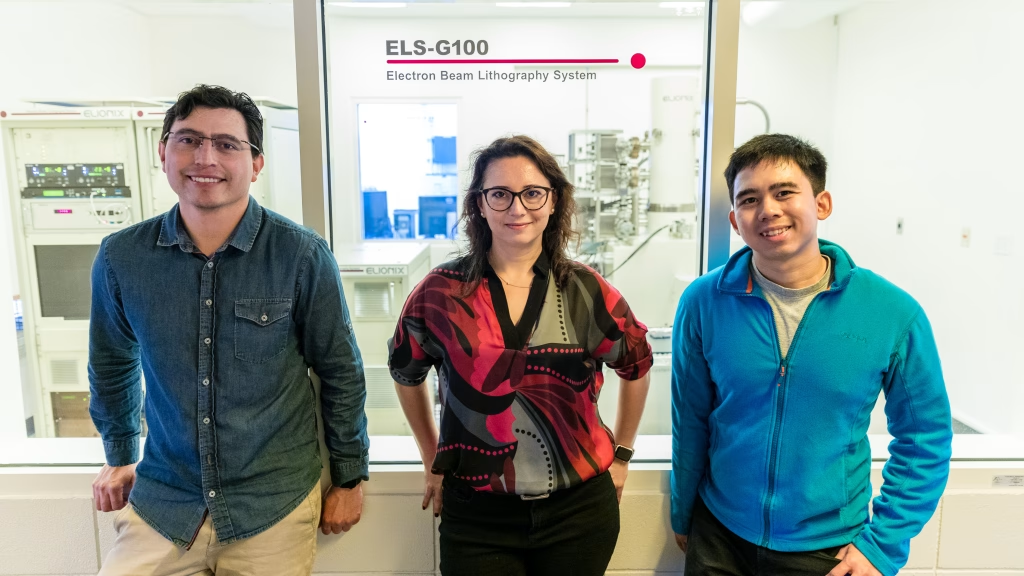A team of University of Wisconsin-Madison biomedical engineers has developed a thin, patterned, silicon-based component that excels at trapping non-visible light and could open up low-cost manufacturing possibilities for biochemical sensors and more.
The group, led by Assistant Professor Filiz Yesilkoy, details its “substrate-less metasurface” in a paper in the journal Nature Communications. In particular, PhD students and co-lead authors Wihan Adi and Samir Rosas and their collaborators highlight the metasurface’s ability to induce light and matter to couple into a hybrid state called polaritons. These quasi-particles are especially of interest in chemistry, where they could alter chemical reactivity.
Metasurfaces are tiny, engineered, nanoscale materials that can manipulate electromagnetic waves, much like how so-called “wave breakers” physically disrupt water waves, says Adi.
“We use our metasurface to trap light. And because the light is trapped, it can interact longer with the molecule,” says Adi.
In this case, the waves are in the mid-infrared range of the electromagnetic spectrum. Infrared light, which has longer wavelengths than visible light, can be useful in applications ranging from astronomy to healthcare. Yesilkoy’s lab is interested in the latter; mid-infrared light could reveal the various molecules in biological samples without requiring any sort of invasive labeling.
“It’s a little bit of a challenging part of the electromagnetic spectrum, because you cannot use conventional materials that are used in traditional optics, where we’re mostly interested in the visible—the wavelengths that we see,” says Yesilkoy, whose research bridges optics (the study of light’s behaviors and properties) and micro- and nanofabrication to develop and improve biosensors, imaging technology and other medical diagnostic tools.
The materials conventionally used in mid-infrared optics also tend to be either brittle or expensive, meaning any devices relying upon them would be difficult to cheaply mass manufacture. And for biosensors to be useful in collecting data from hundreds to thousands of patients to inform medical research, bulk production is essential.
“We really need these sensor chips to be manufactured in bulk so that we have a lot, so that we can decrease their cost and apply them for different applications,” says Yesilkoy.
Instead, Yesilkoy and her students patterned an extremely thin silicon membrane—just one micron thick—that traps light in cavities. When they tested it in the mid-infrared spectral range, they found it trapped light so efficiently that polaritons formed when the light interacted with a polymer sample.
While that capability of the group’s technology is of interest to researchers in the nascent field of polaritonic chemistry, the Yesilkoy lab’s focus remains biosensors. In particular, the group hopes to use the interactions of light and biomolecules to uncover new biomarkers of diseases such as ovarian cancer.
Yesilkoy, Adi and Rosas continue to tweak the patterns on their metasurface to improve its performance.
“This was our first exploration, but now we have a different design that can actually have better control over light, more suited for biosensing applications,” says Yesilkoy. “So that’s where we are pushing.”
 From left: PhD student Samir Rosas, Assistant Professor Filiz Yesilkoy and PhD student Wihan Adi pose in front of a lab that’s part of the Nanoscale Fabrication Center in the Engineering Centers Building. Nanofabrication technology is essential to the Yesilkoy lab’s work creating innovative biosensors. Photos by Tom Ziemer.
From left: PhD student Samir Rosas, Assistant Professor Filiz Yesilkoy and PhD student Wihan Adi pose in front of a lab that’s part of the Nanoscale Fabrication Center in the Engineering Centers Building. Nanofabrication technology is essential to the Yesilkoy lab’s work creating innovative biosensors. Photos by Tom Ziemer.
This research was funded through grants from the National Institutes of Health (grant number R21EB034411) and the National Science Foundation (grant number 2401616).
Top photo caption: PhD students Wihan Adi and Samir Rosas and Assistant Professor Filiz Yesilkoy use a scanning electron microscope in the Materials Science and Engineering Building.